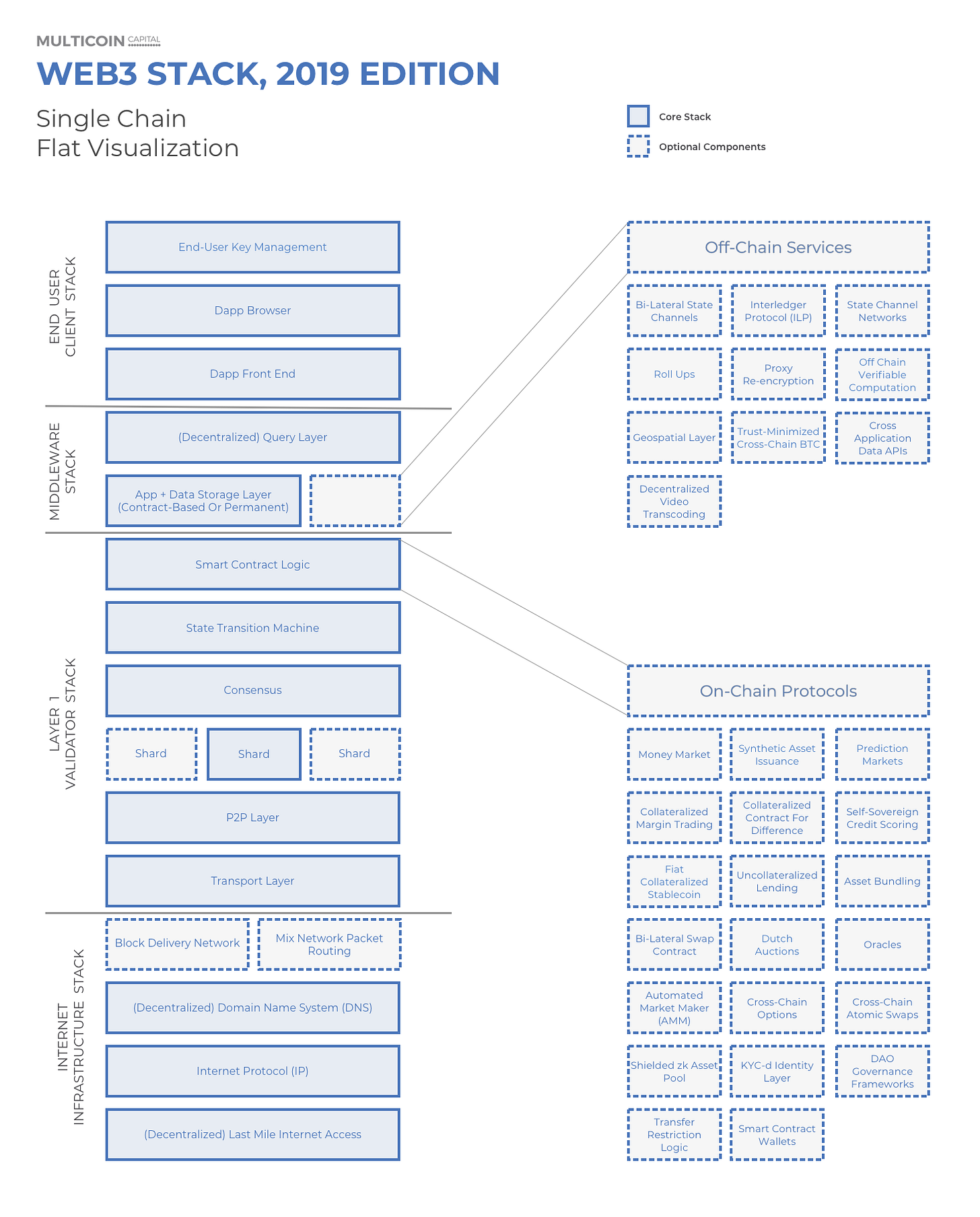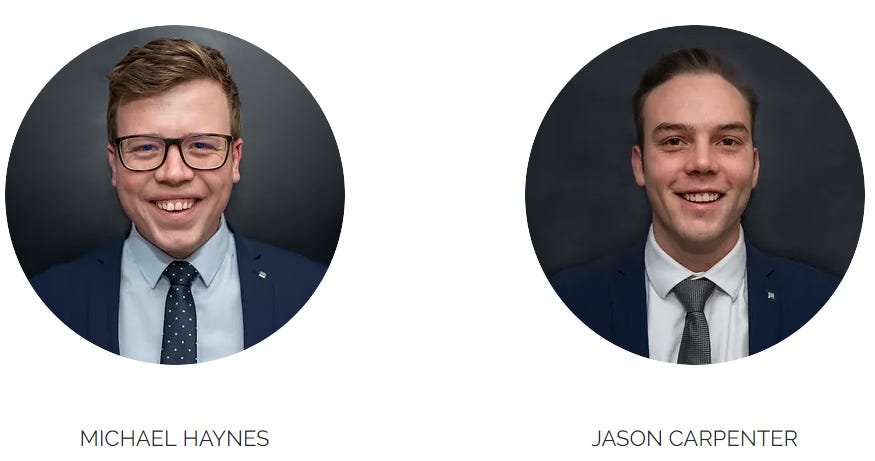Middleware
Market Recap
A Tough Week for Digital Assets
Middleware
Creating a fully functional digitally native economy is vastly more complicated than meets the eye. It requires different protocols, doing various jobs on separate layers. Each one essential in its own right. We have many examples of these protocols that already exist in today's society that we interact with daily. One of the most familiar will be the internet. Below is a diagram of the different protocols or 'layers' that form the internet and make it possible:
This diagram is not complete as many other layers also make up the internet we use today, but it serves to help you visualise some of the most important. On the bottom or link layer, we need a physical mechanism for two computers to send data to one another. However, once a network grows bigger than two computers, we need a way for them to identify one another; that's what the IP protocol in the network layer dictates. Yet, the internet isn't a straightforward path to navigate, and that is what the TCP and UDP protocols dictate; it shows the data where it needs to go. Finally, the application layer is what we are more familiar with, and the protocols within it help us interact with the websites we use on a day to day basis. These are all the basic building blocks of the internet and allow it to function and do its job. Web 3.0 and cryptoasset networks will need their own protocols and layers to function as well. Kyle Samani, a lead thinker in the space, proposed what he dubbed the 'Web 3.0 Stack', a truly decentralised internet of value:
There are many layers that make up the web 3.0 stack, just like the internet. At the bottom, you have the internet infrastructure stack, which its all based on. Above it, you have the Layer 1 Validator Stack, where protocols like Ethereum exist as well as other on-chain (built on Ethereum) protocols that can all play an integral role in further enabling the utility and capabilities of the smart contract protocol they are built on. Many of them will form the base of the Decentralised Financial industry, which we explained in a previous update.
The next layer is the middleware stack, the focus of our article this week. Within it, you will have protocols like a query layer, app and data storage and off-chain services like computation, video transcoding and ways to integrate different chains like Bitcoin and Ethereum.
Query Layer
At Etherbridge, we believe that there are two protocols that belong in the decentralised query layer, indexing protocols and oracles. We explained oracles within a previous update, but here is a brief summary:
Oracles are third-party services that feed smart contracts with external information like prices or weather reports. They serve as the bridge between a blockchain and any outside information. Blockchains cannot innately access external information. This obviously limits the number of use cases they can satisfy. Many contractual agreements require outside information to reliably execute and fulfil the agreement. The use of oracles will significantly broaden the scope of what smart contracts can do. This provides greater functionality to the blockchain ecosystem as a whole. They connect the world to the blockchain.
Indexing protocols connect the blockchain to the world. Indexing is the process of creating tables (or indexes) that point to the location of specific files, data or records. Blockchains and their data are notoriously hard to organise. The process requires looking at each individual block from the beginning of the chain to the end; you can imagine how long this would take considering that the Ethereum blockchain is already over 11 931 723 blocks long. Projects like The Graph are attempting to solve these issues using clever cryptoeconomic incentives where they can get people to create these indexes and earn rewards each time someone wants to access that data in a secure, simple format. It makes developers' lives much more effortless and creates a trustworthy system of accessing blockchain data.
Data Storage Layer
Another crucial element to creating trustless, decentralised applications is storing the data that your layers and protocols will interact with. The current way blockchains are designed makes it very expensive to store data on the actual chain itself. Take Ethereum as an example; all Ethereum nodes keep a full copy of the ledger and need to update it in real-time. If you wanted to store your family pictures or videos on the actual chain itself, you would need to pay every single Ethereum miner to keep them; this makes it prohibitively expensive.
Yes, you could leverage cloud service providers like AWS or Microsoft Azure, but they could, at the flick of a switch, decide to stop your service or delete your data. Not ideal if it is integral to the smooth operation of your application. Therefore, projects like IPFS, Storj and Arweave use blockchain to track and harness peoples' unutilised hard drive space. As a person who has extra capacity on a computer or hard drive that you own, you can now go and rent it out to a global audience of people who want access to decentralised storage solutions.
Compute Layer
Another layer that can significantly increase smart contract platforms' capabilities is the ability to perform complex computations. The cost to perform these computations is similar, if not more expensive than the storage layer. Therefore we have projects like Golem, Ankr and ælf that are also leveraging cryptoeconomic incentives to create off-chain solutions that will allow people to rent out their spare computing power to an open market where anyone can come and use it. This becomes particularly handy when people want to do things like render 3D game or images or even model out DNA profiles.
For the first time, we as consumers of technology can make money off the spare capacity that we have just sitting at home. It is a massive step towards being able to make computers more affordable and accessible to all. It is also a massive challenger to the incumbents in the space where companies like AWS, Microsoft Azure and IBM Cloud have a monopoly over these digital resources.
These are just a few of the different protocols that will exist in the middleware stack. Many more can still be explored, and we will dive into them in future updates. However, as blockchain technology improves and builds out, there is the possibility to disrupt the monopolies that we currently have within society. Open innovation is a breeding ground for great ideas, and humans have historically never shied away from opportunities to create solutions to problems and inefficiencies we currently experience.
We look forward to watching how the Web 3.0 stack builds out going forward.
Notable Articles and News Stories This Week:
Yellen Sounds Warning About 'extremely inefficient' Bitcoin
Janet Yellen, the Treasury Secretary of the United States, commented this week about how inefficient the bitcoin network is. The next story dives into what happened next.
You can read the full story here
The Fed's System That Allows Banks to Send Money Back and Forth Went Down for Several Hours
After Treasury Secretary Janet Yellen commented about bitcoin being inefficient, the US's primary settlement system went down. The "operational error," as the Fed described it, impacted multiple services, including its pivotal automated clearinghouse system, which connects depository and related institutions sending electronic credit and debit transfers.
You can read the full story here
Total Estimated Crypto Users Worldwide Tops 100 million, Survey Finds
By January, the global number of Bitcoin users was estimated to be 71 million compared with 14 million for Ether. Each coin saw a tremendous surge in users that month — 30.2% and 13.1%, respectively.
You can read the full story here
Whilst we all have the option to look, to seek to understand, it’s often easier not to. Bitcoin, Ethereum and distributed ledger technology are complex systems that require significant due diligence. At Etherbridge, we aim to lower the barriers to understanding this fast-growing digital economy.
If you are interested in staying up to date, please subscribe to our newsletter at etherbridge.co
This is not financial advice. All opinions expressed here are our own. We encourage investors to do their own research before making any investments.





